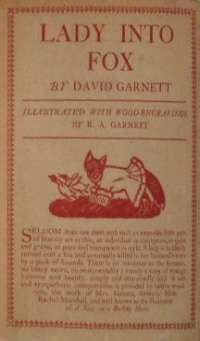Lady into Fox
Lady into Fox was David Garnett's first novel under his own name, published in 1922. This short and enigmatic work won the James Tait Black Memorial Prize, and the Hawthornden Prize a year later. Being a work of Fantasy set in the present-day society, it fits into the category of Contemporary Fantasy which was not yet recognized as a distinct genre at the time of writing.
 Dust-jacket from the first edition | |
| Author | David Garnett |
|---|---|
| Country | United Kingdom |
| Language | English |
| Genre | Fantasy novel |
| Publisher | Chatto and Windus |
Publication date | 1922 |
| Media type | Print (Hardback) |
| Pages | 91 pp |
Plot summary
Sylvia Tebrick, the 24-year-old wife of Richard Tebrick, suddenly turns into a fox while they are out walking in the woods. Mr. Tebrick sends away all the servants in an attempt to keep Sylvia's new nature a secret, although Sylvia's childhood nurse returns. While Sylvia initially acts human, insisting on wearing clothing and playing piquet, her behaviour increasingly becomes that characteristic of a vixen, causing the husband a great deal of anguish. Eventually, Mr. Tebrick releases Sylvia into the wild, where she gives birth to five kits, whom Tebrick names and plays with every day. Despite Tebrick's efforts to protect Sylvia and her cubs, she is ultimately killed by dogs during a fox hunt; Tebrick, who tried to save Sylvia from the dogs, is badly wounded, but eventually recovers.
McSweeney's Collins Library imprint republished Lady into Fox in 2004.
Reception and influence
Rebecca West described Lady Into Fox as one of the "best imaginative productions" of the decade.[1]
The success of the novel led to several imitations. They included a parody by Christopher Ward (1868-1943) Gentleman Into Goose (1924), while Vercors' homage Sylva (1961), depicts a fox transforming into a woman.[2]
Adaptation
In 1939, British choreographer Andrée Howard created a work of the same name based on Garnett's book for Ballet Rambert. Sally Gilmour dancing Sylvia Tebrick assured the ballet's success. The music was an arrangement of piano pieces by Arthur Honegger (Sept pièces brèves and Toccata et variations), setting and costumes designed by Nadia Benois.[3][4][5]
References
- "Thus it happens that all the best imaginative productions of the last decade in England—Walter de la Mare's "Memoirs of a Midget", David Garnett's "Lady Into Fox", Sylvia Townsend Warner's "Mr. Fortune's Maggot", A. E. Coppard's "Best Short Stories" and Virginia Woolf's "Orlando"—have all been in the nature of fantasies". Rebecca West, "A London Letter", The Bookman, May 1929, (p. 293).
- Neil Barron, Fantasy and Horror : a critical and historical guide to literature, illustration, film, TV, radio, and the Internet. Lanham, Md. : Scarecrow Press, 1999. ISBN 0810835967 (p. 116)
- "Judith Mackrell on David Garnett's Lady Into Fox". the Guardian. Retrieved 19 March 2015.
- Oxford Dictionary of Dance 2000. p. 283
- Deryck Lynham: Ballet Then and Now - A History of the Ballet in Europe (Sylvan Press, 1946) - p.154